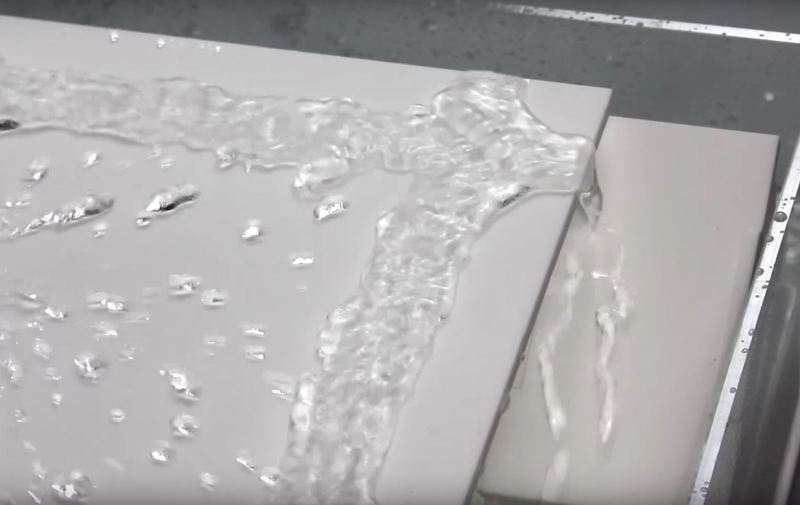Superhydrophobic coating finds a new application in art through [Arthur Carabott] in the form of a bizarre fountain.
A Master’s student in the Global Innovation Design course at the London Royal College of Art, [Carabott] achieved the effect by leaving parts of the laser-cut acrylic untouched by Rust-oleum’s NeverWet Multisurface coating. A 3d printed spigot mounted high above the surface imparts greater velocity to the impacting water so as it hits the acrylic the liquid forms into channels giving the impression of something surreal. Indeed — his design is inspired by the optical illusions of Japanese mathematician Kokichi Sugihara which attempt to realize the impossible artwork of M.C. Escher. The effect is worthy of a double take.
Hydrophobic coatings work by applying a nanoscopic layer to the surface that repels all liquids. Their application can create incredible imagery — like electronics continuing to function despite being submerged in water — so their use in art is a natural outgrowth of this technology.
[via Dezeen Magazine]
















That was so satisfying to watch. I want to make one so bad!
Judging from the scathing Amazon reviews of NeverWet, [Carabott] seems to have found the one and only good use for it. It would be nice to know what pattern of the stuff he used on the acrylic that gives the effect shown.
Super-hydrophobic-fountain-art-is-quite-stupendous.
Aaannnnddd I just got the joke, lol.
Even though the sound of it is really quite horrendous.
If you say it loud enough you’ll always sound tremendous.
Super-hydrophobic-fountain-art-is-quite-stupendous.
Someone had to do it, damn that obsessive compulsive need.
Nano coating humph… Coatings wear off, all do sooner or later. Nano particles in the environment… don’t look good at all. Especially something that interferes with the most important action-reaction on Earth. I am trying to figure if it really is needed. Any old paint will keep what it’s on dry. It would be nice on park benches and picnic tables after a rain, but it will wear off.
It’s with bonding and wear resistance that things either work or fail.
How many outdoor powder coat finishes have you seen cracked and rusting underneath? Glass would do about as well, cause once it cracks it’s done.
That sounds like paranoia, nature is full of nano structured compounds so you can’t make such sweeping statements.
If you know of a specific compound that is structured in a specific way that has actually been shown to be harmful in any way please tell us about it. Links to studies and up-to-date material safety data sheets (MSDS) would be really useful.
MSDS sheets don’t capture the structure, only the compound.
They are not called compound data sheets, there is a difference. A quick search would have made that obvious, e.g. http://zinccorp.com/admin/_images/MSDS/MSDS%20for%20Zinvisible.PDF
I know you mean on the subject of these repelling water compounds, but I can’t help instantly thinking ‘fibreglass?’ in response to your question.
FFS You lot need to look around before hitting the keyboard. That stuff is an example of what I mean, if it is harmful it is documented! http://www.fibreglass.com/MSDS%20PDF/chopped_strand_01_06.pdf
phphphp I eat nano-particles for breakfast. Nano titanium dioxide is in tons of things. OMG Deoxyribo-nucleic acid (DNA) is a nanoparticle WONT SOMEONE THINK OF THE CHILDREN!
Ohh that was good!
ROFL :D
ALL I READ THERE IS ACID! Someone MUST stop these criminals before they STRIKE AGAIN!
@echodelta: “Super-hydrophobic coatings are also found in nature; they appear on plant leaves, such as the Lotus leaf, and some insect wings.”
Yes, and they break down just like most things in nature. Even teeth and coral do.
Man has a way of making things that nature cannot recycle in just time. That Teflon gas that happens when you forgot you were cooking and it overheats.
Forever! As far as were are concerned. The gas emitted is banned in industry. Since anyone can cause these gasses to be created with cookware, should it also be banned? There many other industrial chemicals that have been banned because of persistence in the environment.
Coatings wear off.
I can’t tell if you are joking or not.
Everything is dangerous or can be made to be dangerous.
Water kills more people every week than this hydrophobic coating ever will.
And about environmental persistence; aluminum, glass, motor-oil, water, and most rocks seem to last a long time, so which ones should we ban? This isn’t DDT or lead paint.
If I’m wrong, give us a link.
It’s possible to create a similar hydrophobic surface with lasers, no coating.
http://hackaday.com/2015/01/22/laser-etched-surface-redefines-dry/
Yes, it’s technically possible — but you’ll notice the source mentions it’s done on metal with a fancy laser setup. And maybe you’ve also noticed that the hydrophobic surface looks different from the rest of the metal plate.
You can’t replicate this art installation with that…
https://en.wikipedia.org/wiki/Decamethylcyclopentasiloxane
https://www.youtube.com/watch?v=OzN8uI5USXM
https://www.youtube.com/watch?v=gU4w12oDjn8
Sorry, couldn’t resist!
This would be great for channeling water in an artistic way for arduino automatic plant watering systems.
Or for leaving secret message on urinals, just spray it on through a stencil. :-)
*jumps into car*
*drives to hardware store*
I wonder if a clock could be made with beaded water and strong magnetic fields.
https://en.wikipedia.org/wiki/Diamagnetism#Curving_water_surfaces
https://en.wikipedia.org/wiki/Superhydrophobic_coating
Oh, my. You actually have invented lithography. What would Senefelder think? Oh, right, he’s dead since not quite 200 years…
Nice idea, though. Like it.
Wonder how much it would cost to paint a boat with this stuff, under the waterline of course.